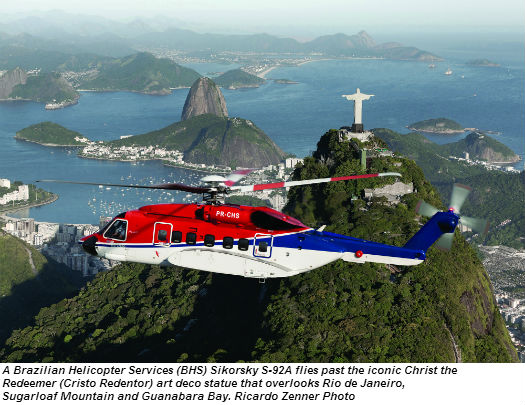
As the clock ticks down to the start of the 2014 FIFA World Cup in São Paulo, Brazil, on June 12, the country is busily preparing for the start of an unprecedented period of international focus. This is because, in just two years’ time, Rio de Janeiro, the country’s second largest city, will host the Summer Olympics. Holding the world’s two biggest sporting competitions in the space of 26 months certainly presents a challenge, but the country is hoping the required changes to its infrastructure — and the events themselves — will serve as a catalyst for modernization, creating a legacy of development among its own people, and inspiring interest and investment from the international community.
But while the nation’s sporting hopes and dreams are set to unfold over the next two years, its expectations for lasting economic growth lie several hundred miles from its brand new stadiums, famed beaches and dramatic coastline, and more than 20 thousand feet below the surface of the Atlantic Ocean. Brazil’s deepwater oil fields already produce more than 90 percent of its estimated 2.65 million barrels per day, helping make it the 10th largest oil producer in the world — but an ambitious development program aims to double this production to about five million barrels per day by 2021.
It hopes that vast reserves recently discovered far from its coastline will propel it into one of the world’s top five oil producers — and a major crude exporter. There are now more deepwater (beyond 1,000 feet/305 meters) and ultra-deepwater (4,920 feet/1,500 meters) exploration platforms off the coast of Brazil than there are in the U.S. Gulf of Mexico, and the rapid pace of offshore development has led to the region being dubbed “the New North Sea,” recalling the offshore boom off the coast of the U.K., Netherlands and Norway in the 1970s.
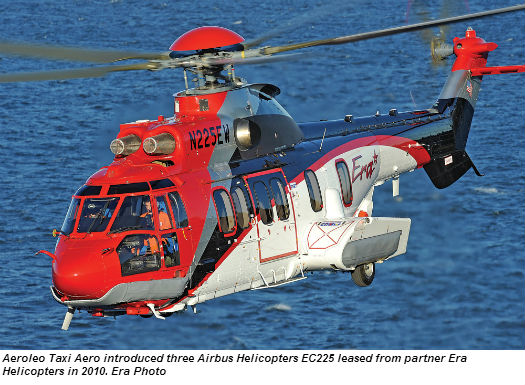
“Brazil now ranks as the world’s single most important deepwater and ultra-deep[water] market,” Mark Duncan, Bristow Group’s senior vice president, commercial, told Vertical. (Bristow purchased a 42.5 percent interest in Brazilian operator Líder Aviação in May 2009, during which time the fleet has grown from 46 to 65 helicopters.)
According to a report by The Economist, Brazil has already discovered as much deepwater oil in the past five years as Mexico has in its entire proven reserves, making it Latin America’s offshore powerhouse.
“Mexico scores high with the largest number of production platforms in Latin America and the Caribbean, but Brazil boasts the largest number of future developments,” Richard Burman, CEO of Omni International, told Vertical. Omni International is a strategic partner of Omni Táxi Aéreo Ltda, one of the three largest operators in Brazil with 54 helicopters.
The growth is believed to lie in the development of giant ultra-deepwater “pre-salt” or “subsalt” oil fields, found up to 200 miles off the country’s southeast coast. The first discoveries of these pre-salt reserves, so called as they lie beneath a layer of salt up to 6,500 feet (two kilometers) thick, were announced in 2007 and 2008 amid much fanfare, and were hailed at the time as being one of the biggest discoveries in the Americas for decades. The responsibility for developing the reserves lies with the state-controlled oil company Petrobras.
The good news for the rotorcraft industry is the anticipated demand this will create for its services, with at least 80 long-range medium- and heavy-lift helicopters, worth an estimated US$1.8 billion, expected to be purchased to help develop the fields over the next six years.
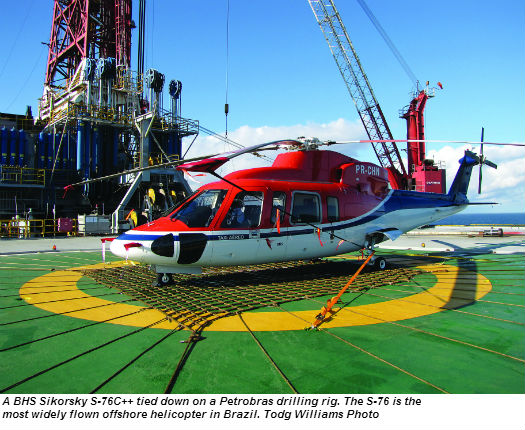
Petrobras
Climb to the top of the 1,299-foot (395-meter) Pão de Açúcar (Sugarloaf Mountain) in Rio de Janeiro and you will have a spectacular view of the large natural harbor that today is a maintenance base for many of the 84 offshore drilling platforms Petrobras and international oil companies currently operate.
Created as a monopoly oil company in 1953 after Brazil nationalized the oil industry, Petróleo Brasileiro S.A. (Petrobras) began exploring the 12 undersea sedimentary basins off the country’s 4,655-mile (7,491-km) coastline for oil and gas in the 1960s, and discovered its first offshore oil field off Rio de Janeiro and Espírito Santo states in the Campos Basin in 1974.
Offshore helicopter operations in the region were pioneered by Lider Táxi Aéreo S/A and VOTEC Servicios Aereos Regionais with the twin-engine Sikorsky S-58T, followed by the Aerospatiale SA330J Puma, Bell 212 and 412, Sikorsky S-61N, and the extremely popular Sikorsky S-76A.
In the mid-1980s, the Brazilian government launched an ambitious program to encourage further offshore exploration in order to reduce its dependence on imported oil — a program that led to the discovery of almost a dozen more oil fields in the Campos Basin.
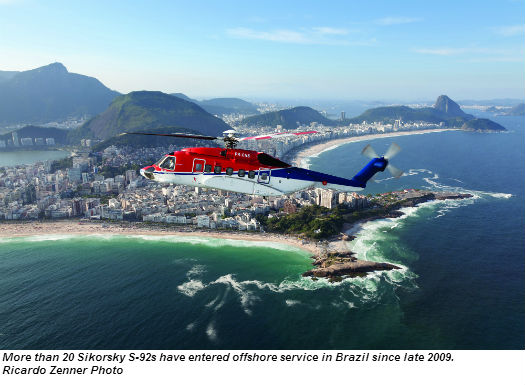
In 1997, the government introduced economic reforms to end Petrobras’ oil monopoly; competition was encouraged and efforts made to attract international oil companies to Brazil. By 2003, there were 41 oil and gas fields offshore in the Campos Basin, producing more than 1.21 million barrels a day.
The S-76A (along with a few Bell 412s and S-61Ns) had become the backbone of the fleet, flying oil workers to well locations between 30 and 87 miles (50 to 140 km) offshore.
Petrobras began drilling in the waters of the Santos Basin — about 160 miles (250 km) from Rio de Janeiro — in 2005. Two years later, the company announced the discovery of its first pre-salt oil field. Containing five to eight billion barrels of oil, the Tupi oil field (later renamed the Lula oil field, after then-Brazilian President Luiz Inacio Lula da Silva) was the world’s largest deepwater oil discovery since 1976 — until it was surpassed by Libra, another Brazilian pre-salt oil field.
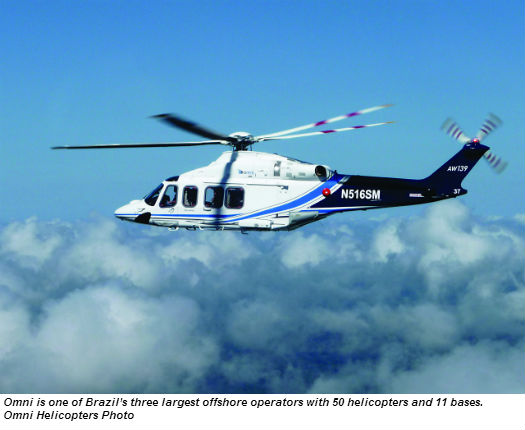
International Investment
The past decade has seen a dramatic change in the Brazilian offshore helicopter industry; with exploration moving into ultra-deepwater, major investment in long-range helicopters has been required.
In 2005, Petrobras had 40 helicopters on contract to support onshore and shallow water offshore activity, and 10 helicopters dedicated to deepwater and ultradeepwater drilling programs, including five AS332L Super Pumas. At the time, eight companies operated the helicopters from 10 airports, one inland in the Amazon and nine on the coast. The fleet carried an annual average of 500,000 passengers a year and notched up an impressive 50,000 flying hours annually, but a Lufthansa Consulting safety study noted that the aircraft were, on average, 20 years old.
Petrobras committed to modernizing the fleet as contracts came up for renewal, and new long-range heavy helicopters were required for deepwater and ultra-deepwater activity.
“Petrobras’ requirement for new long-range heavy helicopters transformed the Brazilian offshore helicopter industry,” said Bristow’s Mark Duncan, explaining that most of the Brazilian operators were challenged by the need to finance helicopters costing more than $20 million apiece.
To meet this challenge, and enable growth, five of Brazil’s six largest offshore helicopter operators partnered with international helicopter operators and investors. Lider Táxi Aéreo S/A partnered with Bristow Group, Omni Táxi Aéreo Ltda with Stirling Square Capital Partners and Omni International), BHS – Brazilian Helicopter Service Táxi Aéreo Ltda with CHC Group, Aeroleo Táxi Aéreo S/A with Era Helicopters, and Helivia Aero Taxi with Greenwich
AeroGroup. The sixth operator, Senior Aero Taxi, partnered with Brazilian company Synergy Group Corp.
As well as providing capital, technical expertise, and assistance in transitioning to an OGP (International Association of Oil & Gas Producers) safety culture, the partners have helped to introduce new talent, new systems and a secure source of aircraft.
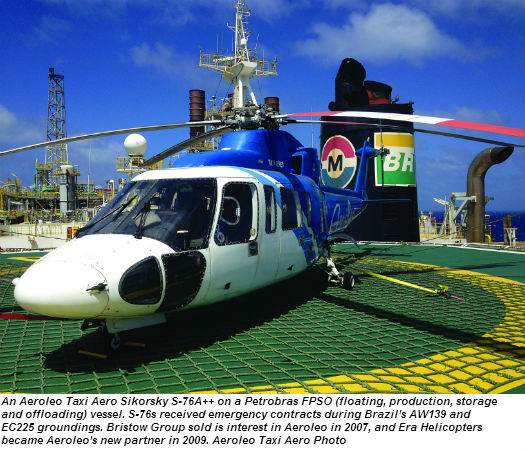
Untangling the Regulations
Although government regulations have allowed international companies to get a toehold in Brazil’s offshore operations, they must still tread a fine line. To operate commercial helicopters in Brazil, an operator must be controlled by Brazilians (“control,” in this sense, defined as having at least 80 percent of an operator’s voting share), and its executive officers must be Brazilian as well. All pilots must be Brazilian nationals or naturalized citizens, and an operator’s technical manager/director must be a graduate aeronautical engineer.
“The ownership and nationality limitations imposed by the Brazilian aviation regulatory authority [ANAC] have resulted in [a] cocooning of the Brazilian offshore aviation industry,” said John Fenton, CEO of Greenwich AeroGroup do Brasil, the parent company of Helivia Aero Taxi. “[There was] no cross-pollination of industry best practices from the North Sea or the Gulf of Mexico.”
But with Petrobras joining the OGP, helicopter operating guidelines are now becoming similar to those of the North Sea.
“Brazil, like other countries, is not without challenges — and business success is very dependent on finding the right people to fill the key positions within an organization,” said Fenton.
This has not been an easy task, with the rapid growth of the country’s helicopter fleet combined with the strict ANAC nationality guidelines.
Foreign instructors can only fly for a short period in Brazil to help get local pilots qualified on new types, making the recruitment and training of new crews a challenge for all operators.
In addition, offshore pilots work 15 days on, then 15 days off, and are limited to a maximum of 80 flying hours a month. Because of this, it’s not uncommon for pilots to change employers for better wages and benefits, with the lure of corporate flying opportunities — of which Brazil has more than most — particularly strong.
Omni Táxi Aéreo has established a helicopter flight training academy in Rio de Janeiro to secure a supply of well-trained pilots, while other companies have made investments in advanced training.
In March 2011, Lider and CAE announced a new joint venture to provide flight training in the country through a CAE 3000 Series Level D fullflight simulator (FFS) with a direct projection visual system for S-76 pilots. The simulator is located at the CAE training Centre in Sao Paulo, South America’s largest urban helicopter market, and was ready for initial and current training in late 2012.
“The S-76 simulator has been a big success; it exceeded our expectations,” said CAE’s Peter Cobb. “We are training most, if not all, the S-76 operators in Brazil.”

Today’s Offshore Fleet
The Brazilian offshore helicopter fleet has tripled in size in less than 10 years. Today, there are 154 helicopters flying to the country’s oil fields, including 122 on contract with Petrobras, 18 on contract with international oil companies, and 14 aircraft operated by five companies flying ad hoc “spot charters” for service providers to the oil companies, such as Diamond Drilling, ENSCO, and Schlumberger.
There are 34 heavy helicopters (14 EC225s and 20 S-92s) contracted by Petrobras through four operators: BHS – Brazilian Helicopter Service Táxi Aéreo Ltda, Lider Táxi Aéreo S/A, Omni Táxi Aéreo Ltda, and Aeroleo Táxi Aéreo S/A.
The 106 medium helicopters on contract for Petrobras and international oil companies at the time of writing were contracted from five companies: Lider (44 S-76A++/ C+/C++ and two Bell 412s), BHS (21 S-76A++/C+/C++), Omni (20 aircraft that include AgustaWestland AW139s, Airbus Helicopters EC155s and AS365Ns), Aeroleo (nine AW139) and Senior Aero Taxi (10 aircraft, including S-76Cs, AW139s and Airbus Helicopters AS365 N3s).
“Brazil’s offshore oil and gas development continues to provide opportunities for increased helicopter support; and we are pleased to meet this demand through our partnership with Era Helicopters,” says Steffen Bay, general manager of Aeroleo. The rapid growth of the fleet has not been without its setbacks. Petrobras grounded all its AW139s between August 2011 and November 2012 after the loss of an aircraft in the Campos Basin. Then, just as the AW139 came back on line, the EC225 fleet was grounded as a result of incidents in the North Sea. Petrobras was the last international oil company to return the helicopter to flight in December 2013.
The negative financial impact of the groundings was partially offset by emergency contracts for other helicopter models.
Big Growth Opportunities
Today, only 10 to 15 percent of the helicopter fleet (about 14 to 21 aircraft) are supporting pre-salt oil fields, but this is where most traffic growth will occur in the next few years.
In 2012, Petrobras contractors flew about 1.2 million passengers over 120,000 flights. The largest concentration (80 percent) was in the southern and southeast region, to offshore developments in the Campos, Santos and Espirito Santo basins.
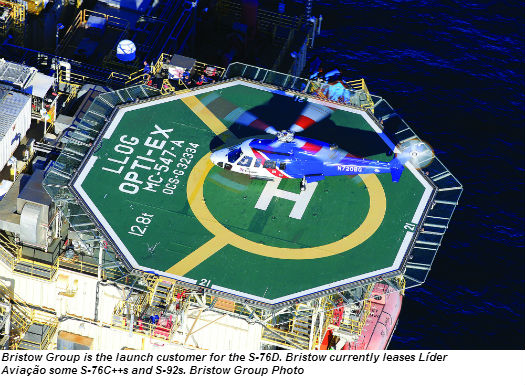
Petrobras estimates that offshore traffic to the Campos and Santos basins alone is going to boost its local passenger numbers by 36 percent, as more than 37 offshore developments come on stream by 2020. To meet this demand, the company says its helicopter fleet in the southern regions will need to grow from about 110 helicopters today to 178 by 2020. New heliports are planned to accommodate this growth, as airports at Macaé and Jacarepaguá (both within 100 miles of Rio de Janeiro) are already saturated with offshore helicopter traffic.
To carry more passengers further offshore, Petrobras has said it will require 27 new generation medium helicopters and 57 new heavy helicopters — offering a huge potential market for the original equipment manufacturers’ (OEMs’) latest line of aircraft. In 2014 alone, Petrobras is expected to issue tenders for up to 12 heavy and 14 medium helicopters, plus two dedicated SAR aircraft.
“Brazil is very much an up and coming market for Sikorsky,” Robert Kokorda, the company’s vice president of sales and marketing told Vertical. “We saw good growth in the early 2000s, and deliveries picked up again after the [worldwide] financial crisis in 2008.”
Kokorda said the S-76 was the most popular offshore aircraft in Brazil, with its latest variant — the S-76D — set t join the Brazilian offshore fleet sometime in the future (Lider partner Bristow is an S-76D launch customer). Sikorsky delivered its first S-92 for Brazilian operation in late 2009, and the aircraft is now flying with Lider, BHS and Omni (Aeroleo partner Era has also placed orders for S-92s).
John Arbach, AgustaWestland’s sales director for Brazil, said the company entered the Brazilian oil-and gas market in 2006 with the sale of three AW139s to Senior. The operator ordered another four in 2009. Today, there are 28 AW139s flying offshore with three operators.
Arbach said the entry into service of the new generation of medium aircraft, such as AgustaWestland’s AW189, would provide a “new twist” to the Brazilian offshore market. “We’re probably going to see the market divided in thirds between medium, super medium and heavy helicopters,” he said. “The AW189 will be able to serve the same distant platforms as the heavy helicopters, but at lower cost, which will give Petrobras tremendous flexibility.” The Bristow Group, Era Helicopters and Omni International have ordered the AW189, creating a pipeline into the market.
Bell Helicopter has similarly high hopes for its Bell 525 Relentless. “The Bell 412 was part of the offshore fleet in Brazil until exploration started moving into deeper waters,” said Jay Ortiz, executive director, Latin America sales and marketing at Bell Helicopter. “Our new Bell 525 is going to be a game changer, and a way to recapture a piece of the offshore market in Brazil. . . . The helicopter will be able to fly long and short missions very cost effectively.”
Thierry Mauvais, marketing planner for the oil and gas segment at Airbus Helicopters, said the temperature and range requirements of Brazilian operators were well matched to the company’s product line and aircraft performance. “The EC175 and the EC225 are ideal for the Brazilian offshore market as they cover the whole range of [offshore oil] platforms, giving operators the best cost per seat ratio,” he said.
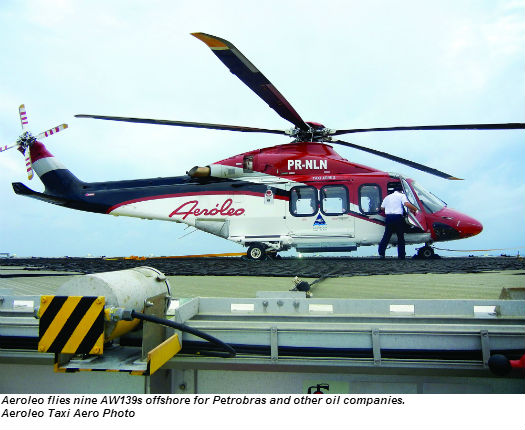
Helicopter financing and early delivery positions are essential to secure Petrobras contracts. Milestone Aviation Group launched its leasing business in 2010 with the delivery of two Sikorsky S-76C++ to Omni.
“We have since been active in a number of offshore helicopter transactions with Lider, Omni and BHS in Brazil for AW139s, EC225s and S-92s,” says Robert Dranitzke, managing director of Milestone. “We have orders with three helicopter manufacturers, which means we can meet the short lead times common in Brazil.”
In 2010, Brazil introduced a new Buy Brazilian Act, which calls for state-owned companies (including Petrobras) to give priority to domestic products when issuing calls for tenders. Because of this, OEMs are looking at ways to boost their footprint in Brazil to capture new government, offshore and military sales.
Perhaps the best established is Airbus Helicopters’ Helibras, which recently celebrated its 35th anniversary, and is now locally producing the EC725 Cougar (the military version of the EC225) for the Brazilian Air Force. Meanwhile, AgustaWestland is in the process of tripling the size of its Brazilian support and training facility, and Sikorsky has established a local spare parts inventory and is also creating a local training center.
Creating a Legacy
The offshore helicopter industry in Brazil is more than 40 years old, but the last decade has seen the fleet almost triple in size. Another 14 new generation medium and heavy helicopters will be required each year if the country is to achieve its ambitious plan to double offshore oil production by 2021 — as well as the highly-trained pilots and mechanics needed to operate them.
But those looking to join the market must also navigate carefully through restrictive regulatory requirements designed to ensure the benefits of the pre-salt reserves are felt by Brazilians back on the mainland. “The subsalt is a gift from God,” said former president Lula da Silva. “Well explored and well managed, it can create big transformations in Brazil.”
The country is almost ready for its moment in the spotlight of international competition, but Brazil’s longest lasting legacy over the next couple of years is likely to be formed by the development of its offshore oil — for which helicopters will play vital a role.





